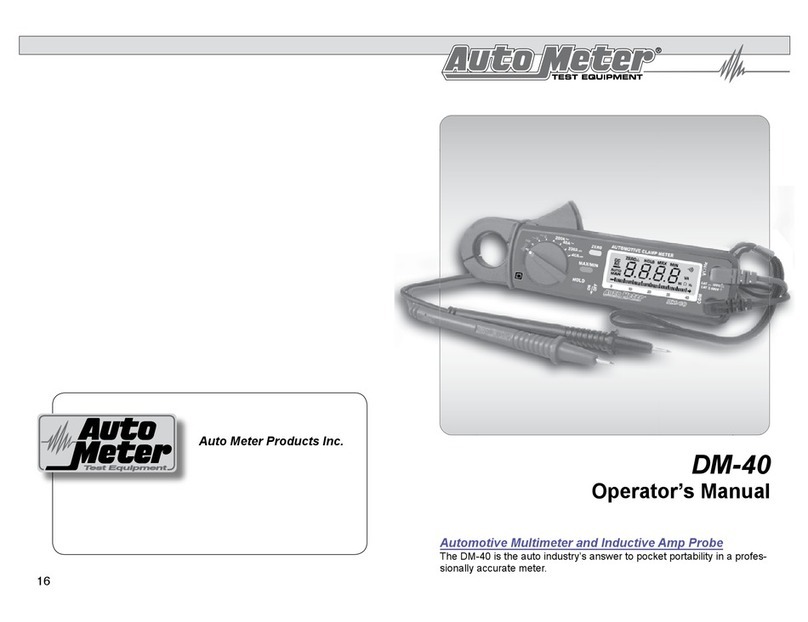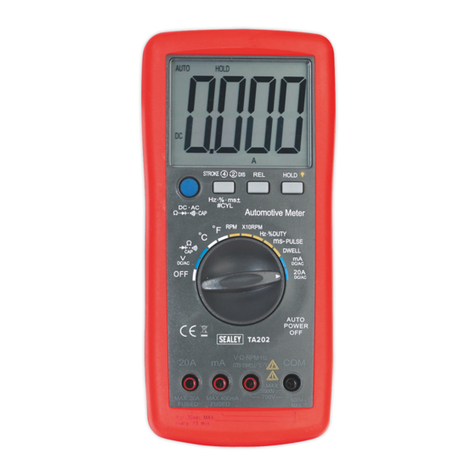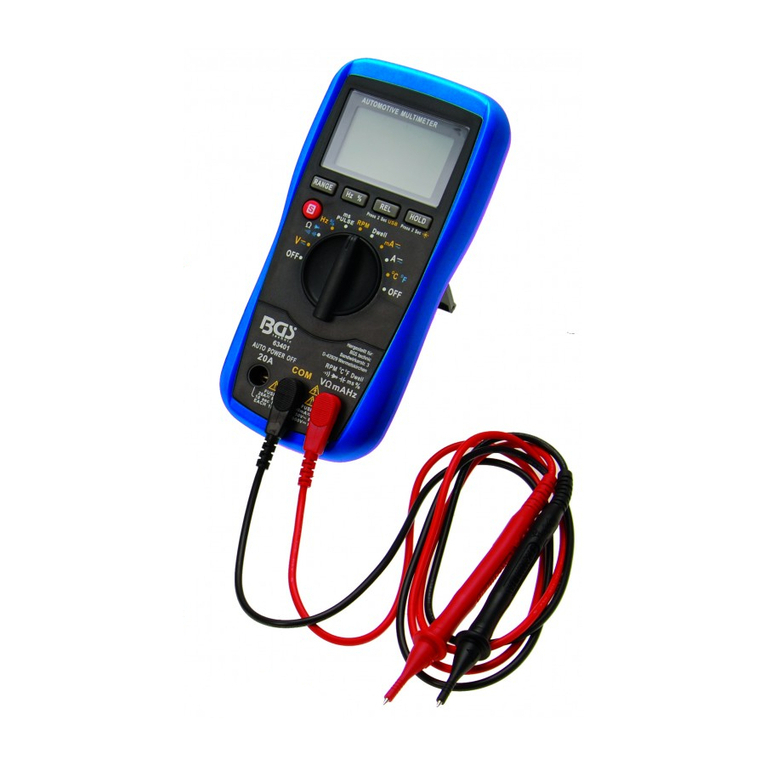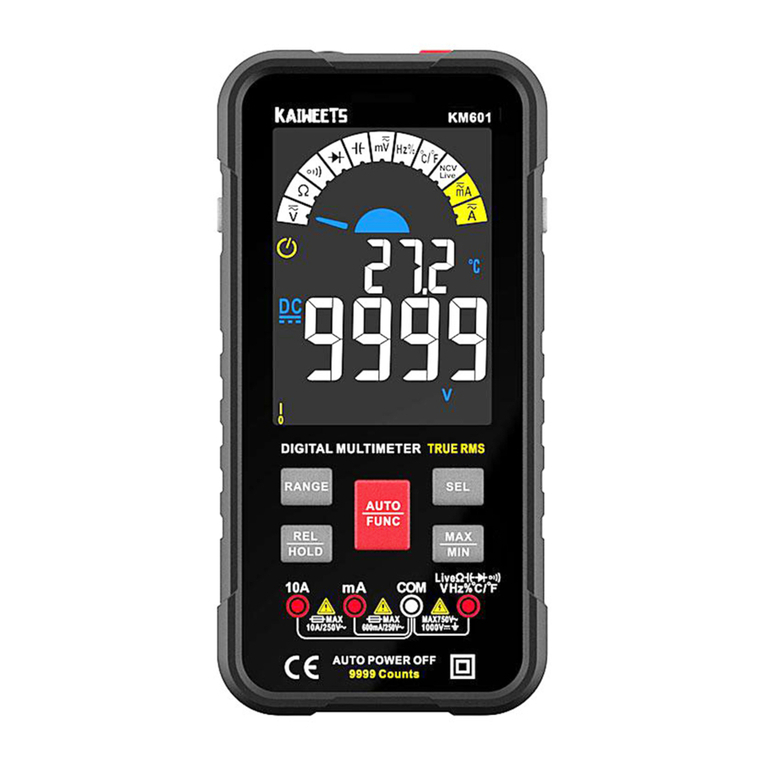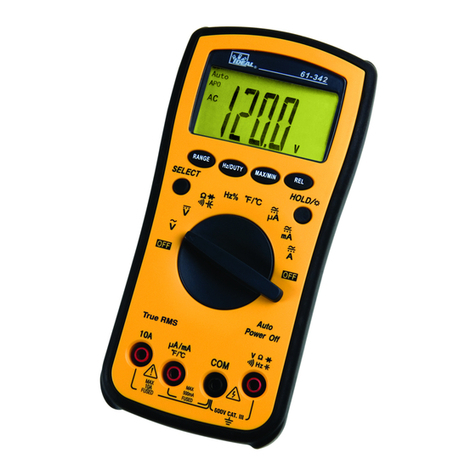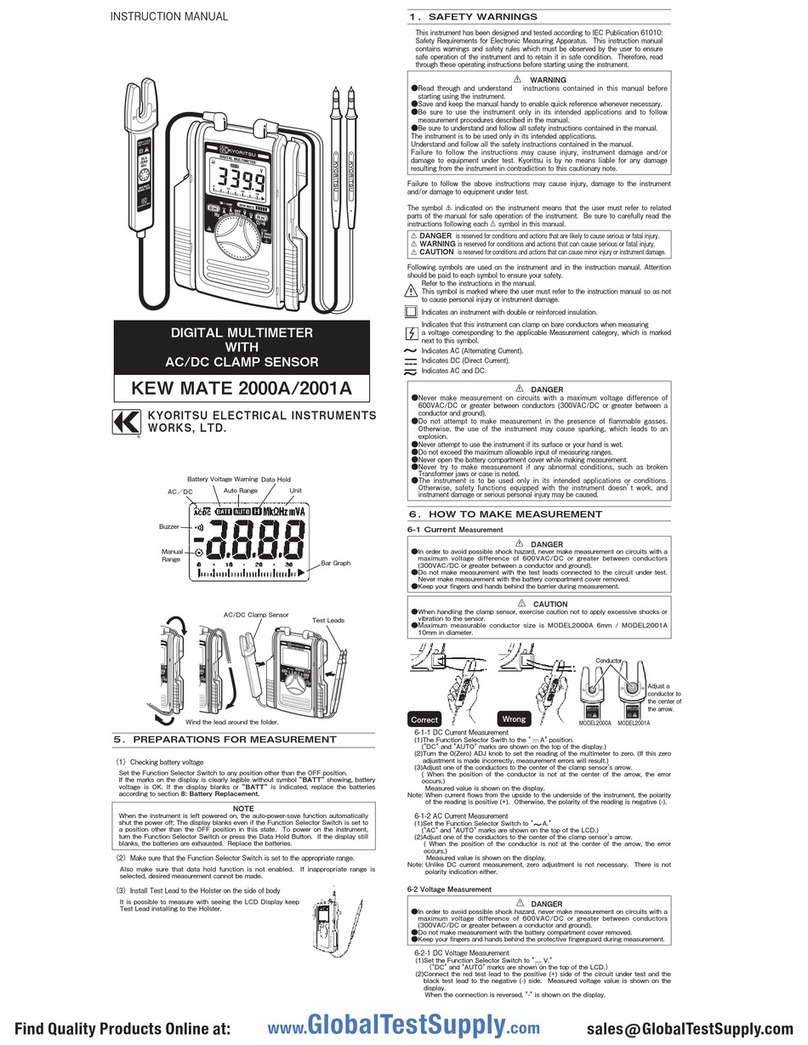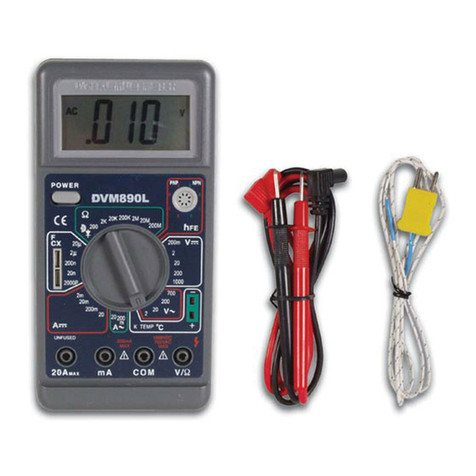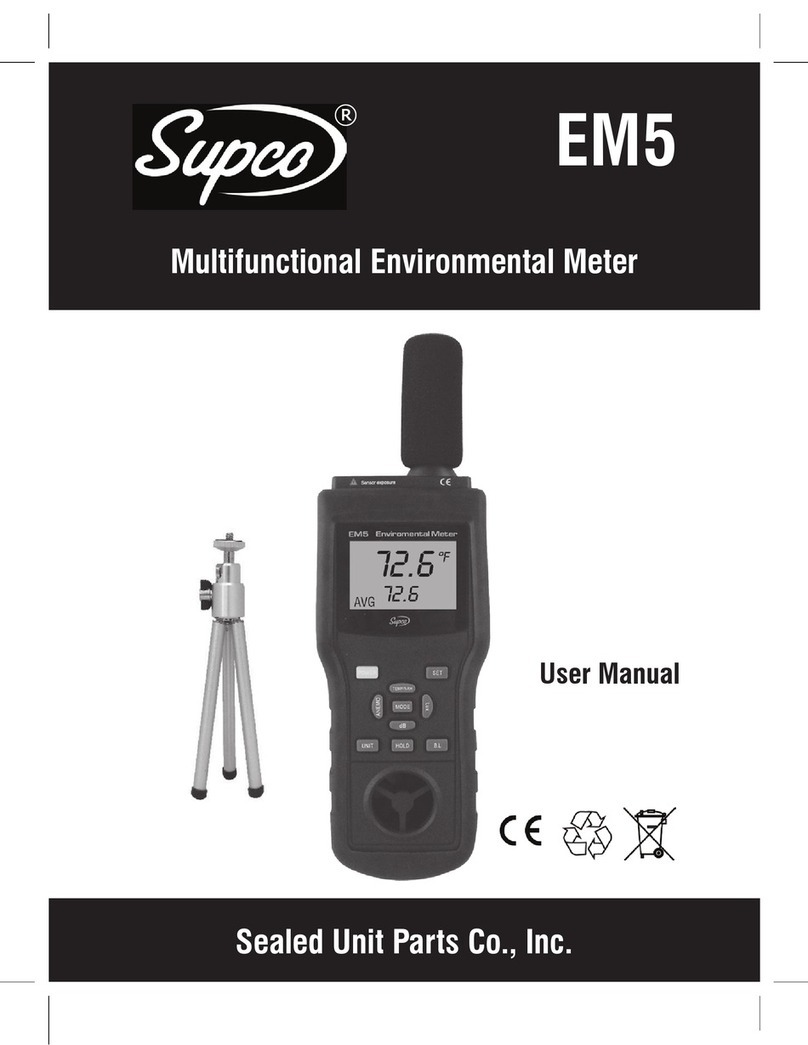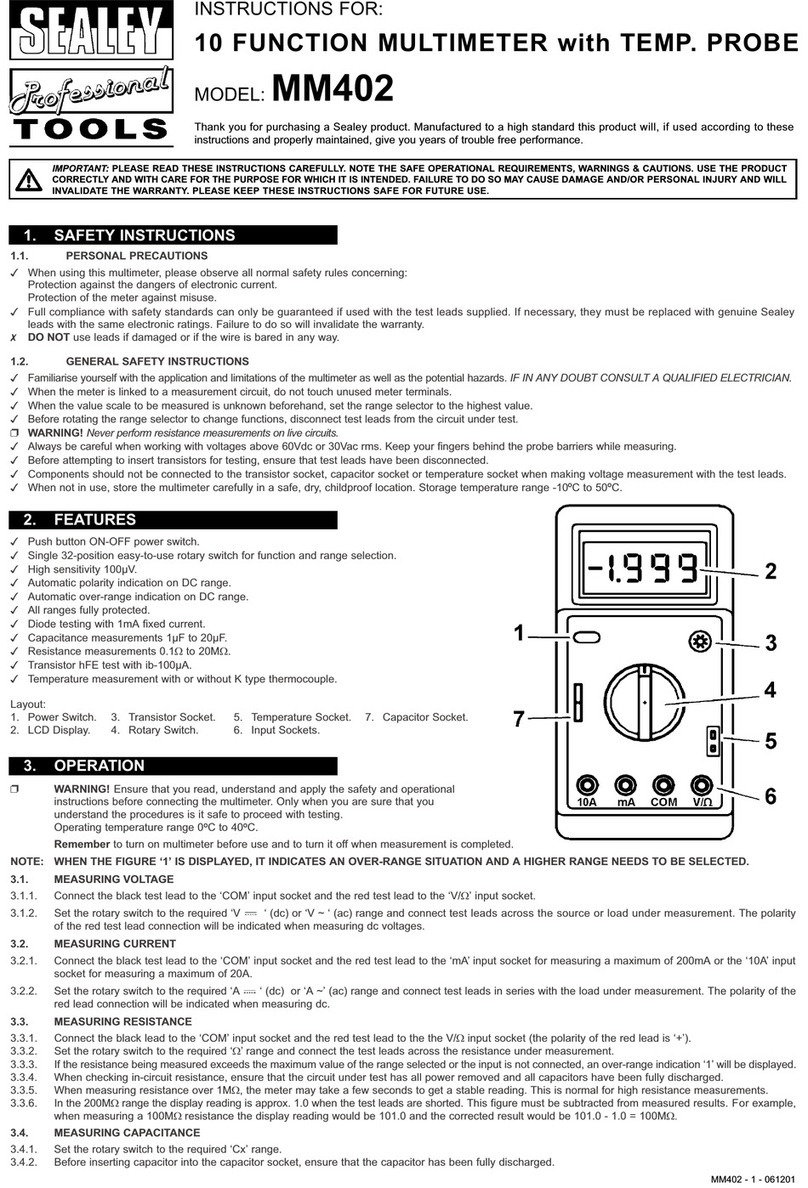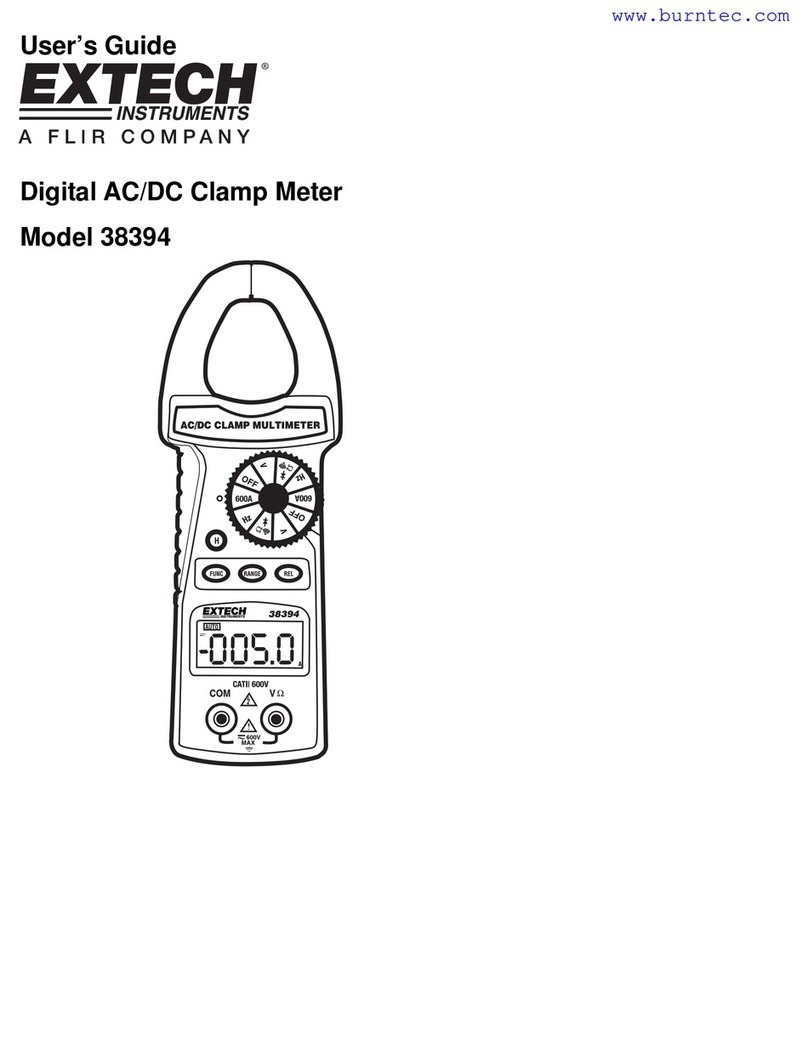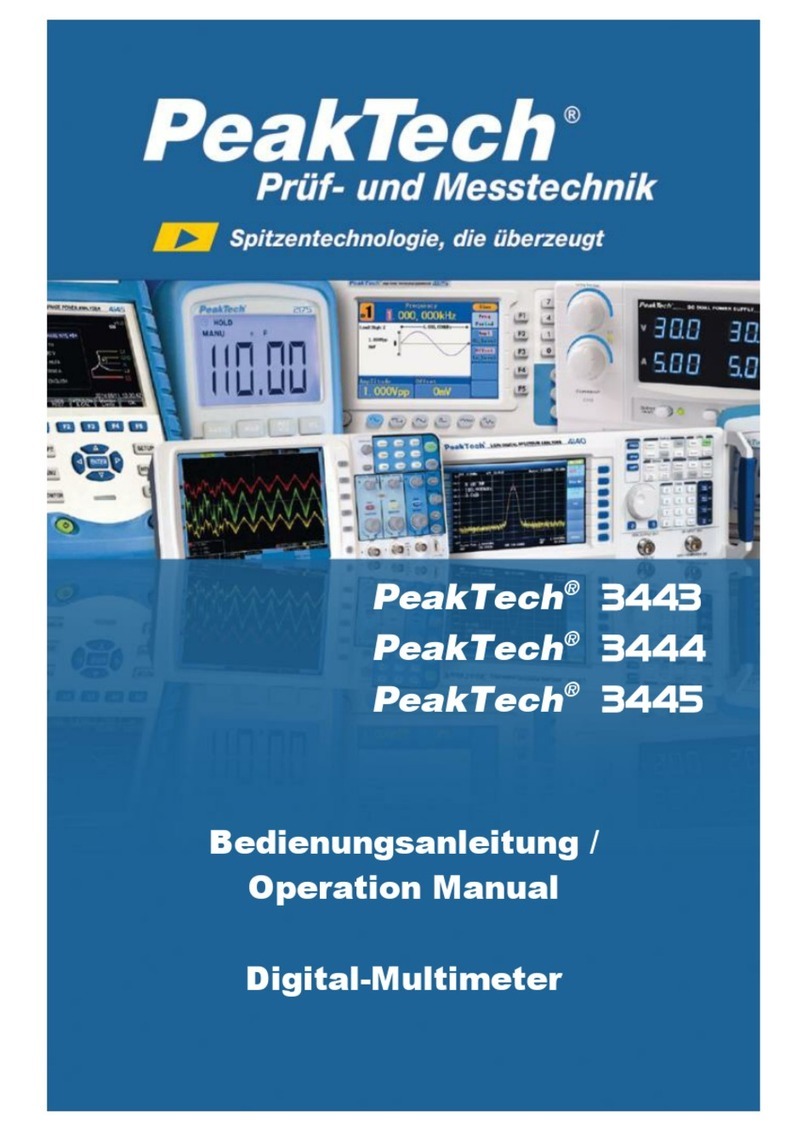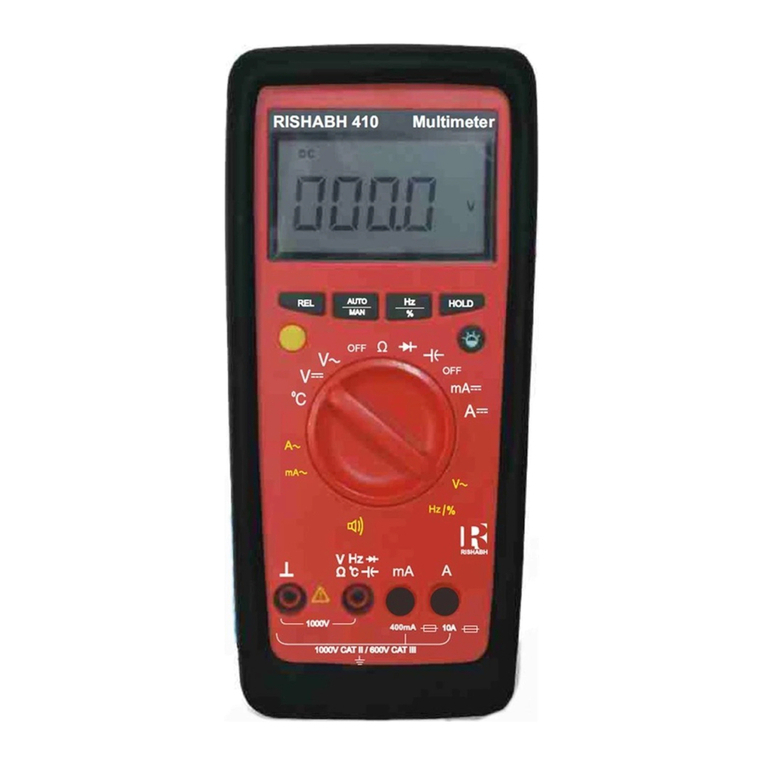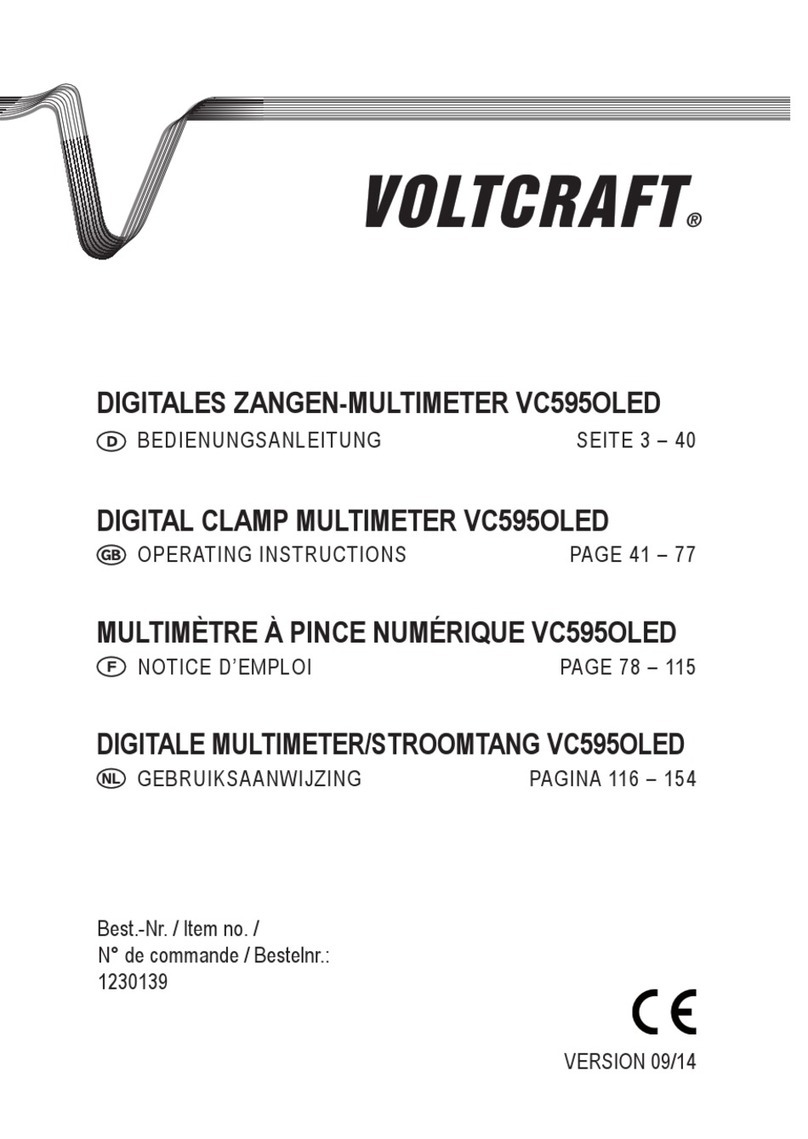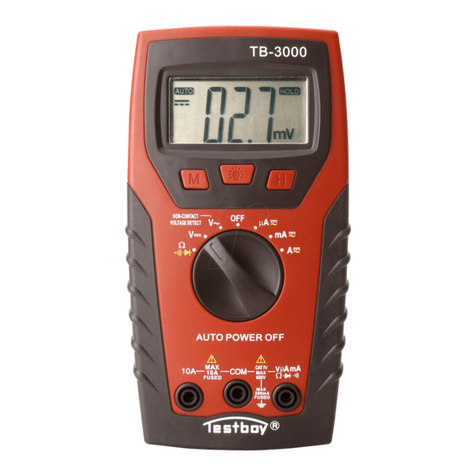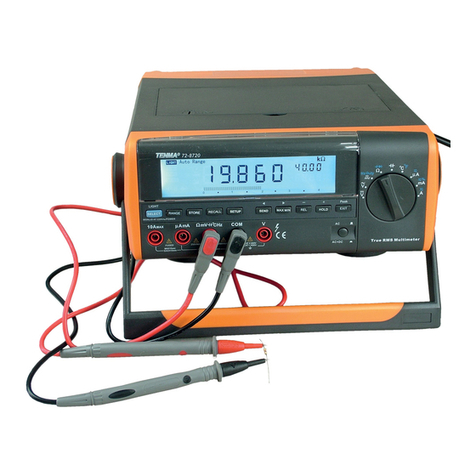AutoMeter DM-46 User manual

DM-46
Instruction Manual
Automotive Multimeter and Inductive Amp Probe
The DM-46 is the auto industry’s answer to pocket portability in a
professionally accurate meter.2650-1910-77 11/9/16
Auto Meter Products Inc.
413 West Elm Street
Sycamore, IL 60178
Service (815) 899-0801
Toll Free (866) 883-TEST (8378)
www.autometer.com/test
Test Equipment
�
20 1

LIMITED WARRANTY
TABLE OF CONTENTS
SERVICE
For service send your product to Auto Meter in a well-packed shipping
carton. Please include a note explaining what the problem is along with
your phone number. If you are sending the product back for Warranty
adjustment, you must include a copy (or original) of your sales receipt
from the place of purchase.
12 MONTHS FROM DATE OF PURCHASE-CABLES 90 DAYS
The manufacturer warrants to the consumer that this product will be
free from defects in material or workmanship for a period of twelve
(12) months from the date of original purchase.
Products that fail within this 12 month warranty period will be repaired
or replaced at the manufacturer’s option to the consumer, when
determined by the manufacturer that the product failed due to defects
in material or workmanship. This warranty is limited to the repair or
replacement of parts and the necessary labor by the manufacturer to
effect the repair or replacement of the product. In no event shall the
manufacturer be responsible for special, incidental or consequential
damages or costs incurred due to the failure of this product.
Improper use, accident, water damage, abuse, unauthorized repairs
or alterations voids this warranty. The manufacturer disclaims any
liability or consequential damages due to breach of any written or
implied warranty on its test equipment.
WARRANTY AND SERVICE INFORMATION
Warranty claims to the manufacturer’s service department must be
transportation prepaid and accompanied with dated proof of purchase.
This warranty applies only to the original purchaser and is non-
transferable. Shipper damage incurred during return shipments is not
covered under this warranty. It is the responsibility of the shipper (the
customer returning the Test Equipment) to package the tester properly
to prevent any damage during return shipment. Repair costs for such
damages will be charged back to shipper (customer returning the Test
Equipment). Protect the product By shipping in original carton or add
plenty of over-pack cushioning such as crumpled up newspaper.
Maintenance and Cleaning-------------------------------2
Safety ----------------------------------------------------------3
Battery Replacement --------------------------------------3
Features-------------------------------------------------------4
Controls and Functions--------------------------------- 4-5
Operation Instructions
DC/AC Current Measurements ---------------------6
DC/AC Voltage Measurements ---------------------7
Diode Test------------------------------------------------8
Capacitance Measurment----------------------------8
Temperature Measurement--------------------------8
Resistance Measurement----------------------------9
Continuity Test ------------------------------------------9
Frequency Measurment ---------------------------- 10
Duty Measurment ------------------------------------ 10
Diode Test---------------------------------------------- 10
Relative Reading Measurements ---------------- 10
Holding the LCD Reading-------------------------- 11
Finding the MAX/MIN Value ----------------------- 11
Change Auto-range Mode to Manual Mode --- 11
Disable Auto Power Off ----------------------------- 11
Charging System Tests
State of Charge -------------------------------------- 12
Amp Draw Check ------------------------------------ 12
Alternator Test ---------------------------------------- 13
Starter Draw Test ------------------------------------ 14
Specications ---------------------------------------------- 15
Warranty ---------------------------------------------------- 19
MAINTENANCE and CLEANING
Periodically wipe the case with a damp cloth and detergent;
do not use abrasives or solvents.
Use the hand strap to avoid accidental dropping. Negligent
use of your meter will void the warranty.
Keep away from heat and liquid solvents.
Keep in a protective place when not in use.
2 19

SAFETY
Carefully read all operating instructions before using the DM-46
Wear eye protection when working around batteries.
Keep sparks, ames, or cigarettes away from batteries.
Keep hair, hands, and clothing as well as tester leads and cords
away from moving blades and belts.
Provide adequate ventilation to remove car exhaust.
WARNING: If the clamp meter is used in a manner not specied
by the manufacture, the protection provided by the clamp meter
may be impaired.
EN 61010-2-032
CAT II 600V
CAT III 300V
Pollution Degree2
Denition of Symbols
on the DM-46 and in
the manual.
Caution: Refer to
Accompanying
Documents
Caution: Risk of Electric
Shock
Double Insulation
Overvoltage Category I (CAT I):
Equipment for connection to circuits in which
measures are taken to limit the transient
overvoltages to an appropriate low lever.
Overvoltage Category II (CAT II):
Energy-consuming equipment to be
supplied from the xed installation.
Overvoltage Category III (CAT III):
Equipment in xed installations.
NOTES
BATTERY REPLACEMENT
1. Turn the power off and remove the test leads from
the clamp meter.
2. Remove the screw of the battery
cover.
3. Lift and remove the battery
cover.
4. Remove the old batteries.
5. lnsert two (AA) batteries.
6. Replace the battery cover and
secure the screw.
When the low battery symbol is displayed on the LCD or the LCD is dark,
replace the old batteries with two (AA) batteries.
18 3
DUTY:
Range
(<10KHz)
Resolution
(Hz)
Accuracy Sensitivity
1-99% 0.1% 10d 10V
DIODE TEST:
Range Resolution Accuracy Overload
Protection
0-1.999V 0.001V 2.5% 5dgts AC 600V
+
-+
-
SPECIFICATIONS CONTINUED

FEATURES
10mA high resolution on 40A DC/AC range.
Temperature (Degrees C or F) and Capacitance
One touch zero for DCA adjustment.
Auto-range for V, A, Ω, F, and temperature
Frequency (Hz).
23 mm diameter jaw.
Fast bar graph display (30 times/sec.) for transient observation.
Continuity and frequency measurements.
Max/Min and Data Hold functions.
600V overload protection for ohm measurement.
Ideal for working in crowded switch box or cable areas.
CONTROLS AND FUNCTIONS
1. Transformer Jaw is used to pick up current signal. It measures DC/AC
current. The jaw must enclose the conducting wire.
2. Transformer Trigger is used to open the jaw.
3. Function Selector Switch is used to select the function such as DCA,
ACA, DCV, ACV, Hz, Ohm and Continuity.
4. AC/DC select switch. This is used to select AC or DC voltage or
current, Hz or Duty, Ohm or Continuity, Capacitance or Diode, °F or °C.
5. Data Hold Button holds the LCD reading when pushed. Press again
to release it. This button is not available in continuity or diode function.
6. Max/Min Hold Button. This button is used to enable the maximum
or minimum value to be displayed and updated during measurement.
Press once, minimum value shall be display and updated. Press again,
maximum value shall be displayed and updated. Zero function will be
disabled if MAX/MIN is enabled. This button is not available in Duty,
Hz, Continuity, Diode or Capacitance function.
SPECIFICATIONS CONTINUED
417
TEMPERATURE (K Type Thermal Couple w/ Adapter, °C or °F):
Range Resolution Accuracy Overload Protection
-40-0°C 0.1 °C 2.0% 2 °C AC 600V
0-400°C 0.1 °C 0.5% 2°C AC 600V
400-1000°C 1°C 0.5% 2 °C AC 600V
-40-0°F 0.1°F 2.0% 4°F AC 600V
0-400°F 0.1°F 0.5% 4°F AC 600V
400-1800°F 1°F 0.5% 4°F AC 600V
RESISTANCE (Ω):(open voltage 0.4V)
Range Resolution Accuracy Overload Protection
400 Ω0.1 Ω1.5% 2dgts AC 600V
4K Ω1 Ω1.5% 2dgts AC 600V
40K Ω10 Ω1.5% 2dgts AC 600V
400K Ω100 Ω1.5% 2dgts AC 600V
4M Ω1K Ω1.5% 2dgts AC 600V
40M Ω10K Ω1.5% 2dgts AC 600V
CONTINUITY (open voltage 0.4V, Overload Protection Ac600V)
Range Resolution Accuracy Beeping
40-400 Ω0.1 Ω1.0% 2dgts <10.0 Ω (approx)
FREQUENCY: (Auto, sensitivity selected by pressing RANGE Button)
Range
(Hz)
Resolution
(Hz)
Accuracy Sensitivity Overload
Protection
1-100K 0.001-100Hz 0.5% 2dgts 5V AC 600V
+
-+
-
+
-+
-
+
-+
-
+
-+
-
+
-+
-
+
-+
-
+
-+
-
+
-+
-
+
-+
-
+
-+
-
+
-+
-
+
-+
-
+
-+
-
+
-+
-
CAPACITANCE:
Range Resolution Accuracy Overload Protection
40nF 10pF 5.0% 0.2nF AC 600V
400nF 0.1nF 3.0% 0.2nF AC 600V
4μ1nF 3.0% 0.02μFAC 600V
40μF10nF 3.0% 0.02μFAC 600V
400μF100nF 3.0% 0.02μFAC 600V
+
-+
-
+
-+
-
+
-+
-
+
-+
-
+
-+
-

CONTROLS AND FUNCTIONS
7. VΩRANGE Zero/Relative Button. On voltage or ohm function,
press this button to select manual range.
On other functions, once this button is pressed, the current reading
shall be set to zero and be used as a zero reference value for all
other subsequent measurement. The function is also used to remove
offset value caused by residual magnetism remaining in the core
for the DC current measurement. The Zero/Relative function will
be disabled if the MAX/MIN button is pressed. This button is not
available in Duty, Hz, Continuity, Diode function.
8. LCD is a 3 3/4 digit Liquid Crystal Display with a maximum indication
of 3999. The functions included are units, symbols, bar graph, sign,
decimal points, low battery symbols, max/mim symbols, and zero
symbol. Press the zero button again to disable this function.
9. Battery Symbol appears if the battery voltage drops below the
minimum required voltage. Refer to page 3 for battery replacement.
10. Zero/Relative Symbol means a reference value has been
subtracted from the actual reading. The reading shown is an offset
value. Press the zero button again to disable this function.
11. Data Hold Symbol appears on the LCD when the hold button is
pressed.
12. Bar Graph has forty segments. It displays segments proportional to
the actual reading. Each segment represents one count.
13. MAX or MIN is displayed on the LCD when the MIN/MAX button is
pressed.
14. Continuity Symbol. If continuity function is selected, this symbol
shall appear on LCD.
15. Units are displayed on the LCD when a function is selected. The
corresponding symbols are: V, A, Ω, and Hz.
16. V, Ω, Hz, Capacitance, Temperature input Terminal.
This terminal is used as input for voltage, ohm/continuity, frequency,
capacitance or temperature measurements..
17. COM Terminal (Black) is used as a common reference input.
18. Hand Strap allows you to put your hand through to avoid
accidentally dropping the clamp meter.
SPECIFICATIONS (23oC 5oC)
16 5
Range Resolution Accuracy Overload Protection
40A 10mA
+
1.5% +2dgts DC 400A
0-150A 100mA
+
1.5% +2dgts DC 400A
150-200A 100mA
+
2.2% +2dgts DC 400A
DC Current
- -
- -
- -
AC Current
Range Resolution Accuracy Overload
Protection
50/60 Hz 40-1 KHz
40A 10mA
+
1.5% +2dgts
+
2.5% +2dgts AC 400A
0-150A 100mA
+
1.5% +2dgts
+
2.5% +2dgts AC 400A
150-200A 100mA
+
2.2% +2dgts
+
2.5% +2dgts AC 400A
- -
- -
- -
- -
- -
- -
DC Voltage: (Overload Protection: 600V)
Range Resolution Accuracy Input Impedance
400mV 0.1mV
+
1.5% +3dgts 2.3MΩ
4V 1mV
+
1.5% +3dgts 2.3MΩ
40V 10mV
+
1.5% +3dgts 2.3MΩ
400V 100mV
+
1.5% +3dgts 2.3MΩ
600V 1V
+
1.5% +3dgts 2.3MΩ
- -
- -
- -
- -
- -
Range Resolution Accuracy Overload
Protection
50/60 Hz 40-1 KHz
0.01-4V 1mV
+
1.5% +5dgts
+
2.0% +5dgts AC 800V
40V 10mV
+
1.5% +5dgts
+
2.0% +5dgts AC 800V
400V 100mV
+
1.5% +5dgts
+
2.0% +5dgts AC 800V
600V 1V
+
1.5% +5dgts
+
2.0% +5dgts AC 800V
AC Voltage: (Input Impedance 2.3MΩ)
- -
- -
- -
- -
- -
- -
- -
- -
+
-

1. Set the rotary switch at 40A or 200A and move the
sliding switch to DC.
2. Push the zero button to zero reading the Amp reading.
3. Press the trigger to open the jaw and fully enclose the
conducting wire to be measured. Be sure there is no air
gap between the two half jaws.
4. Read the measured value from the LCD.
DC/AC CURRENT MEASUREMENTS
WARNING: Make sure that all the test leads are disconnected
from the meter’s terminals for current measurement.
DC CURRENT
AC CURRENT
1. Set the rotary switch at 40A ~ or 200A ~, and move the
sliding switch to AC.
2. Press the trigger to open the jaw and fully enclose the
conducting wire to be measured. Be sure there is no air
gap between the two half jaws.
3. Read the measured value from the LCD.
SPECIFICATIONS
Conductor Size: 23mm max. (approx.)
Battery Type: two 1.5V AA
Display 3 3/4 LCD with 40 seg. bar graph
Range Selection: manual
Overload Indication: OL
Power Consumption: 10mA (approx.)
Low battery Indication
Sampling Time: 3 times/sec. (display)
30 times/sec. (bar graph)
Auto-Power-Off 15 Minutes
Operating Temperature: -10oC to 50oC
Operating Humidity: less than 85% relative
Altitude: up to 2000M
Storage Temperature -20oC to 60oC
Storage Humidity less than 75% relative
Dimension: 7.2” x 2.5” x 1.4”
Weight: 190g (battery included)
Accessories: Adapter for Capacitance and
K-type Thermal Couple
Carrying bag
Instruction Manual
B
615

DC/AC VOLTAGE MEASUREMENTS
WARNING: Maximum input for DC V is 600, and for AC V is
600. Do not attempt to take any voltage measurement that
exceeds the limits. Exceeding the limits could cause electrical
shock and damage to the meter.
DC VOLTAGE
AC VOLTAGE
1.
Set the rotary switch at V and move the sliding switch to DC.
2. Insert the test leads into the input jack.
3. Connect the test prods of the test leads in PARALLEL to the
circuit to be measured.
4. Read the measured value from the LCD display.
1. Set the rotary switch at V ~
and move the sliding switch to AC
.
2. Insert the test leads into the input jack.
3. Connect the test prods of the test leads in PARALLEL to the
circuit to be measured.
4. Read the measured value from the LCD display.
STARTER DRAW TEST
STARTER SETUP
1. Check with manufacture’s proper procedure to disable ignition if
needed. Improper methods could cause damage to vehicles that
are computer controlled.
2. Determine the manufactures Starter Draw specications. If not
available use the following chart as a guide.
3. Select DC 200 Amp and zero the DM-46 by pressing the yellow
button.
4. Press the MAX/MIN button twice and make sure the display reads
HOLD MAX.
5. Clamp the DM-46 around the positive conductor leading to the
starter (See illustration above). Make sure the small arrow inside
the clamp is pointing in the direction of the current towards the
starter. Also make sure the DM-46 is clear of any moving belts,
fan blades or anything that might damage the meter.
6. Crank the engine for 3 to 5 seconds.
7. Read the DM-46 and compare with manufactures specications.
8. High Amp reading indicates a faulty starter or engine timing
that would put an extra load upon the starter. Possible starter
problems are shorted windings, bent armature, broken housing or
bad bearings.
14 7

CAPACITANCE and TEMPERATURE
DIODE TEST
1. Plug the adapter into the terminal.
2. Insert the the capacitor into the adapter.
3. If the capacitance is less than 4nF press zero
(capacitance) button to zero the residual capacitance.
4. Read the capacitance from the LCD.
TEMPERATURE
1. Plug the adapter into the terminal.
2. Insert the K-type thermal couple into the adapter
3. Read the temperature from the LCD.
ALTERNATOR TEST
ALTERNATOR
SETUP
1. Select DC Volts on the DM-46.
2. Start the engine.
3. Place the Volt leads to the red (+) positive and black (-) battery
terminals.
4. Allow voltage to stabilize. The reading should be from 13.0 to 15
Volts DC.
5. Turn on all accessories including the headlights.
6. The reading should be from 12.8 to 15 Volts DC. If the reading
is low the alternator is not charging. If the reading is high the
alternator is over charging and could damage the battery.
7. Switch the DM-46 to DC 200 Amps.
8. Clamp the DM-46 around the positive alternator conductor leading
to the positive terminal of the battery (See illustration above).
9. Make sure the small arrow inside the clamp is pointing in the
direction of the current towards the battery. Also make sure the
DM-46 is clear of any moving belts, fan blades or anything that
might damage the meter.
10. If output is lower in DC Amps than the accessories would draw
then the alternator may not be charging. Repeat step 6 to see if
the voltage has droped.
11. Select the AC 40 Amp on the DM-46.
12. Clamp the DM-46 as shown above.
13. With the engine still running and all accessories on, the current
ripple should be less than 10 Amps AC. If more, the diodes are
bad.
8 13

RESISTANCE MEASUREMENT
1. Set the rotary switch to Ω.
2. Insert the test leads into the input jack.
3. Connect the test probes of the test leads to the two ends
of the resistor or circuit to be measured.
4. Read the measured value from the LCD.
CONTINUITY TEST
WARNING: Before taking any in-circuit resistance
measurement, remove power from the circuit being tested and
discharge all the capacitors.
1. Turn the rotary switch to Ωposition and move the sliding
switch to AC position.
2. lnsert the test leads into the input jack.
3. Connect the test probes of the test leads to the two ends
of the resistor or circuit to be measured.
4. Read the measured value from the LCD.
5. lf the resistance is lower than 10 Ω, a beeping sound
will be heard.
CHARGING SYSTEM TESTS
The following section shows what you can do
with the DM-46 in testing your charging system
State of Charge
1. Select DC Volts on the DM-46.
2. Place the Volt leads to the red (+) positive and black (-) battery
terminals.
3. If the Volts are less than 12.5 Volts the battery needs charging.
Amp Draw Check
4. Turn off ignition and all accessories.
5. Select DC 40 Amps on the DM-46.
6. Zero the DM-46 by pressing the yellow button.
7. Clamp the DM-46 around the positive (+) battery cable . Make
sure it is clamped around all wires.
8. If the display is above 2 Amps there is probably a draw upon
the battery by the electrical system. This will drain the battery.
Isolate and follow a suspected circuit and repeat reading until
the problem is found. Consider a negligible drain with an on
board computer.
12 9

1. Set the rotary switch at Hz.
2. Insert the test leads into the input jack.
3. Connect the test prods of the test leads in PARALLEL to
the signal or circuit being measured.
4. Read the measured value from the LCD display.
1. Set the rotary switch at Duty.
2. Insert the test leads into the input jack.
3. Connect the test prods of the test leads in PARALLEL to
the signal or circuit to be measured.
4. Read the measured value from the LCD display.
1. Set the rotary switch at diode.
2. Insert the test leads into the input jack.
3. Connect the test prods of the test leads to the two ends
of a diode.
4. Read the diode voltage from LCD.
RELATIVE READING MEASUREMENTS
DUTY MEASUREMENT
DIODE TEST
The zero button also can be used to make a relative
measurement. Once the button is pushed, the current reading is
set to zero and a zero symbol will be displayed on LCD. All the
subsequent measurement shall be displayed as a relative value
with respect to the value being zeroed. Press the zero button
again to return to normal mode. But this function is disabled
if MAX/MIN function is enabled. Please watch for symbol
displayed on LCD.
Press the HOLD button and the reading will be held on the
LCD.
FINDING THE MAX/MIN VALUE
Press the MAX/MIN button to enable the maximum and
minimum values to be recorded and updated during
measurement. Push the button once, the maximum value will
be displayed and updated. The LCD display toggles between
the MAX and MIN values. To exit MAX/MIN function, press
and hold the MAX/MIN button for more than 2 seconds.
If MAX/MIN button is pressed, the ZERO function will be
disabled and the ZERO symbol will disappear from LCD.
CHANGE AUTO RANGE MODE TO MANUAL
DISABLE AUTO-POWER-OFF
If users want to select certain range for specic measurement,
they can press the VΩRANGE button to select appropriate
range. To return to auto-range, press and hold the VΩRANGE
button for 2 seconds.
The meter will turn itself off 15 minutes after power-on (A
symbol of APO is displayed in LCD). Also pressing any button
or turning the rotary switch will reset the 15 minute timer.
To disable the Auto-Power-Off function, hold the HOLD button
while turning on power.
10 11
HOLDING THE LCD READING
FREQUENCY (Hz) MEASUREMENT
Table of contents
Other AutoMeter Multimeter manuals
